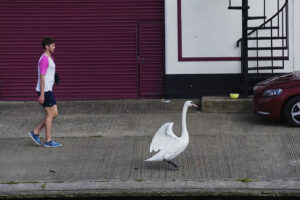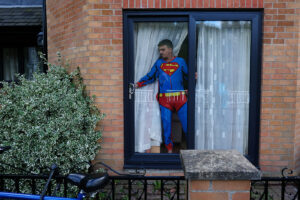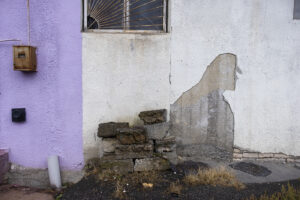

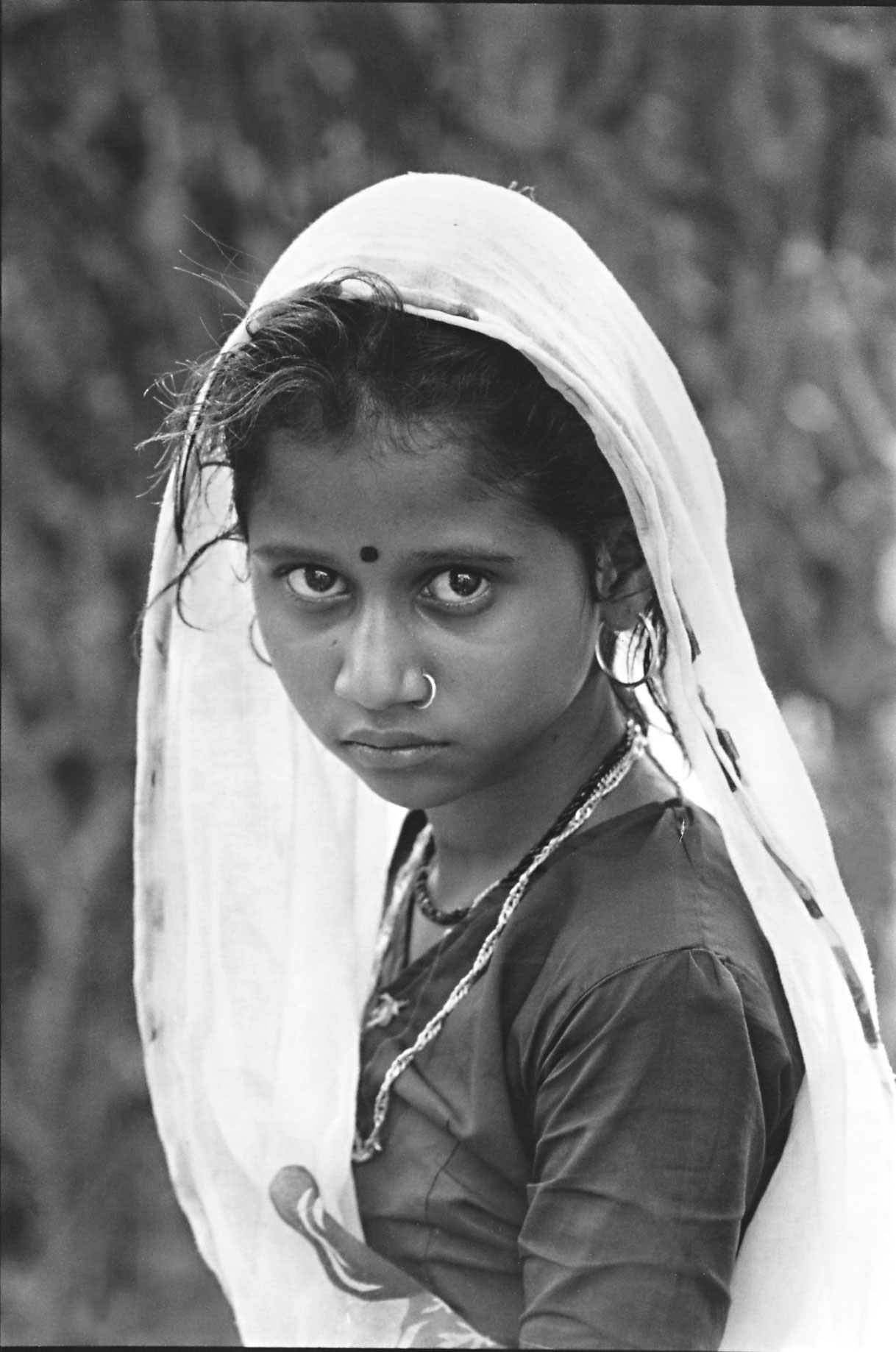
SANTANU MITRA
The life of an errant photographer
Santanu was brought up in Bombay the first few years of his life. Remembering those days he recollects, “The light was different in those days, clearer somewhat.” Sure it was clear, because the Bombay of the 60’s was windswept with almost no pollution. His earliest memories are the Marine Drive, the Gateway of India at Apollo Bunder, constructed to commemorate the landing in 1911of King Emperor George V, the coconut wallahs and the mumphali seller, horse drawn carriage rides, Colaba Causeway, The hushed thin air of Khooshru Bagh and Muhammed Rafi sahib singing on most radios in the little shops of 1st Pasta Lane. And at home, gorging on Chotoder Ramayan and Chotoder Mahabharat published by Deb Shahitto Kutir. His first ever comic format literature.
When he was almost 7, his uncle returned from Germany with an unusual gift for him. Chocolates yes, cookies yes, even two EP vinyl records with Besame Mucho and the House of Bamboo!! But most importantly, he gifted the child a camera. An Agfa Isoly II 120, hand wound 120mm negative film, 12 shots to a roll. Available setting was only the aperture; f4, f4 with a yellow filter and F11. That was it. His father used it initially. Family trip to Ajanta, Ellora, Aurangabad, Khandala to the Hanging Gardens on top of Malabar Hills et al.
The story pauses there. Santanu comes to Calcutta with his father. Life became busy with school and growing up. But like many of his mates, watching films became a passion…irrespective of genre, language or taste! Parallel to this his diet consisted of comics like the Phantom, Mandrake, Flash Gordon, and in Bengali Sukhtara were his favourites.
Thus grew an interest in images. Constructed images. A choice of selection, what to see [in the frame] and what to leave out. A political, poetic, moment freezing choice. By high school, Santanu, had taken up his long lost gift, the Isoly II. So began a journey, quite by chance but guided by some unknown inner quest for defining space, to capture emotions, to hold a story in one’s hands, to comment as a social being.
After college, Santanu heard of an institution called Chitrabani, a multi disciplinary media centre directed by Fr. Gaston Roberge. He joined two courses concurrently, one as a member of team of photographers in an informal training programme headed by Brian Balen and with Deepak Mazumdar in a course in Social Communication.
The former taught him the skills, for by then he had acquired an Asahi Pentax MX [for a princely sum of Rs. 2,500/-] and most of his fellow photographer and he would share a 400 feet AGFA NP22 cine film roll and then cut it up in the darkroom to roll them in 35mm film cans. 36 exposures each!! The latter however, gave Santanu a chance to hone his skill. Over and above the assignments from the Photo Department, which focussed on Calcutta, a city of diverse people, shooting life on the streets concentrating on people and public spaces, his course in Social Communication took him to the rural hinterland of Bengal. Travelling to festivals far in the villages, crossing rivers, staying awake nights, listening to blissed out bauls in the throes of euphoric singing, the Chau dancers dancing to the primordial beat of forest drums whirling and rolling with the beats… It was a new world of magic and amazement.
Thus began Santanu’s journey as a professional photographer. A photo essay with a write-up by him sold to Namaste, the ITC in-house magazine. There was no looking back. He went to Delhi and contacted several travel and culture magazines for work and after his debut, he was good enough to be published by some of the best magazines of this genre. For the next six years he survived as a travel photo journalist and published with Destination India, Namaste, Swagat and several Travel Guides. During this time he travelled to the far corners of his country, diverse, rich, colourful and intricate.
While in Calcutta, he freelanced with the Telegraph newspaper, mostly in the area of culture and stage. He travelled to four consecutive Khajuraho Dance Festivals, covered the Bolshoi at Rabindra Sadan and the International festival of Dance and Theatre, a seven day affair with the top exponents in the field attending. Anna Halprin, Richard Shechner, Eugino Berba, Panikker from Kerala, Badal Sirkar, Girish Karnad, B V Karanth, Sunil Kothar just to name a few. While not working for the Telegraph, he freelanced and got odd jobs like travelling with the Head of Cinematography of Murdoch University Perth Australia, Peter Jeffery, to meet top film directors of India like Mrinal Sen, Satyajit Ray, Mani Kaul, Basu Chatterjee among others. Santanu was still an informal part of Chitrabani was making multiple Carousel transparencies [slide] projections. He was also actively shooting Mother Teresa for almost two years off and on, for CARE, a sponsor of the Missionaries of Charity. With Mother Teresa he experienced the Home for the destitute and Dying, the Leprosy colonies in Asansol, the Nirmal Hriday with inmates covering all forms of human handicaps and victims of social apathy.
Soon he shifted base to Delhi and joined The Indira Gandhi National Centre for the Arts under Dr. Kapila Vatsyayan, working in the archival field of Photography. Santanu photographed the art works of Elisabeth Sass Brunner and her daughter who coming from Europe in the 30’s travelled through China, Tibet, Burma and India to document the life of people there. They spent time with Rabindranath Tagore who’s philosophy influenced them greatly. He worked on the production team of Aakara, an international exhibition on Calligraphy. He painstakingly shot the Neolithic rock cave art of Bhimbhetka with Dr. Yashodhar Mathpal, a giant in the field. But the icing on the cake was when IGNCA acquired the complete photographic effects of Raja Lala Deen Dayal, the erstwhile Court Photographer to Mehboob Jah 6th Nizam of Hyderabad. Santanu was deputed to catalogue and pack and bring to Delhi the said effects! This comprised almost 2,500 hand coated emulsion glass plate negatives, sizes, 15×20, 12×16, 8×10 and 4×6 inches. Six view cameras made mostly in the United Kingdom and Germany, several lenses, innumerable POP prints of Army Officers and their wives and servants, The Royal Court, nautch girls in their finery, children of the aristocracy, palanquins, hunts and dances …the list goes on.
This was a treasure trove for Santanu, who lovingly catalogued and packed each and every item to be shipped back to the IGNCA. He recalls, “I think I really did learn a lot during those days. How a pioneer photographer documented his times with such care and perfection using not so user friendly equipment was verily a task for the toughest.”
After two years at the IGNCA, Santanu joined The Times of India, New Delhi, as a press photographer. During is six year tenure with the TOI, he covered all kinds of usual press assignments, from football to fashion, from murders to rallies, from politician to under-trials. He covered three riots at Khurja, Aligarh and Meerut. His portfolio includes the Mandal Commission unrest and he recalls, “Having to shoot with tear gas all around was a real challenge, it’s the police who taught us how to keep salt in one’s mouth for some relief.” He was there when Rajeev Goswami committed self immolation and was rewarded with the front page the day after. He covered Lal Krishna Advani on his Rath Yatra, Murli Manohar Joshi on Ekta Yatra to Kashmir, and climbed onto an AN32 cargo aircraft to cover the last sprinkling of the ashes of Rajiv Gandhi over the Himalayas with the hatch open at -24 degrees Celcius. “The sight of the mighty Himalayas from that height is unbelievable”, he says. He was appointed Chief Photographer Economic Times for the last two years of his tenure at TOI.
After resigning from the TOI, he joined television as a Producer and produced India’s first Art Review Show, State of the Art with Jessica Lall as presenter and also produced The Inside-Outside Show, a programme based on Architecture, Interiors and Usable Art. He also produced his first ever documentary on the Bauls of Bengal.
As his interest developed, Santanu started working as a Line Producer for projects of the BBC, Channel4, Canal Plus, TF1, TF24, Thalssa, Arte etc. He covered four Kumbh Melas and worked as Interpreter, Researcher, Cameraman, and Fixer.
In the early 2000’s he was asked by a friend, and ex-boss, to join as a Photo Editor for two newspapers in Nepal. Santanu’s work was to put a team of local photographers into a cohesive team and supervise the work of the department. He would , also, have to travel extensively all over Nepal to document local issues there, be they refugees, Maoists or local festivals and craft.
After successful completion of his brief, he returned to Calcutta where he joined as HoD of Media Studies at a renowned University. But his shifty feet wouldn’t let him be bound to a desk. He started freelancing again for foreign channels and private producers, and teaching a bit o the side. As he still does.
Santanu has exhibited in Calcutta, New Delhi, Kathmandu, Oslo and Arendal in Norway and Stockholm. But for all exhibits he is immovable on one count. “I like to keep my photographs full frame, no cropping. That is why I leave the natural black border of the negative gate in the frame. I somehow feel it adds to the authenticity of my endeavours”, he says. And then sighs, “Digital age has deleted all that.”
When asked what he got out of life as a photographer, he smiles. His eyes look inwards. Then afer a pause he says, “Photography has been my life and learning. When you are looking at the face of Pandit Mallikarjun Mansoor through a 180mm, 2.8, you can feel his voice rip through you. When you see a smoking jugghi jhopri colony after a recent fire through a 20mm you can see the devastation in one glance. When you see the Nagas rush to Ganga ji during Shahi Snan through a 400mm. it’s the energy of the moment that grips you by your throat. Photography has brought life to me in a way that I would never ever have seen as a civilian, and yes, I do mean a civilian. It’s because a photographer is always a Samurai. He has to have the eye, the sense and the reflex to capture a moment that can become timeless!”
[Disclaimer: A lot of jargon may not be understandable by young readers or non-photographers. We apologise.]
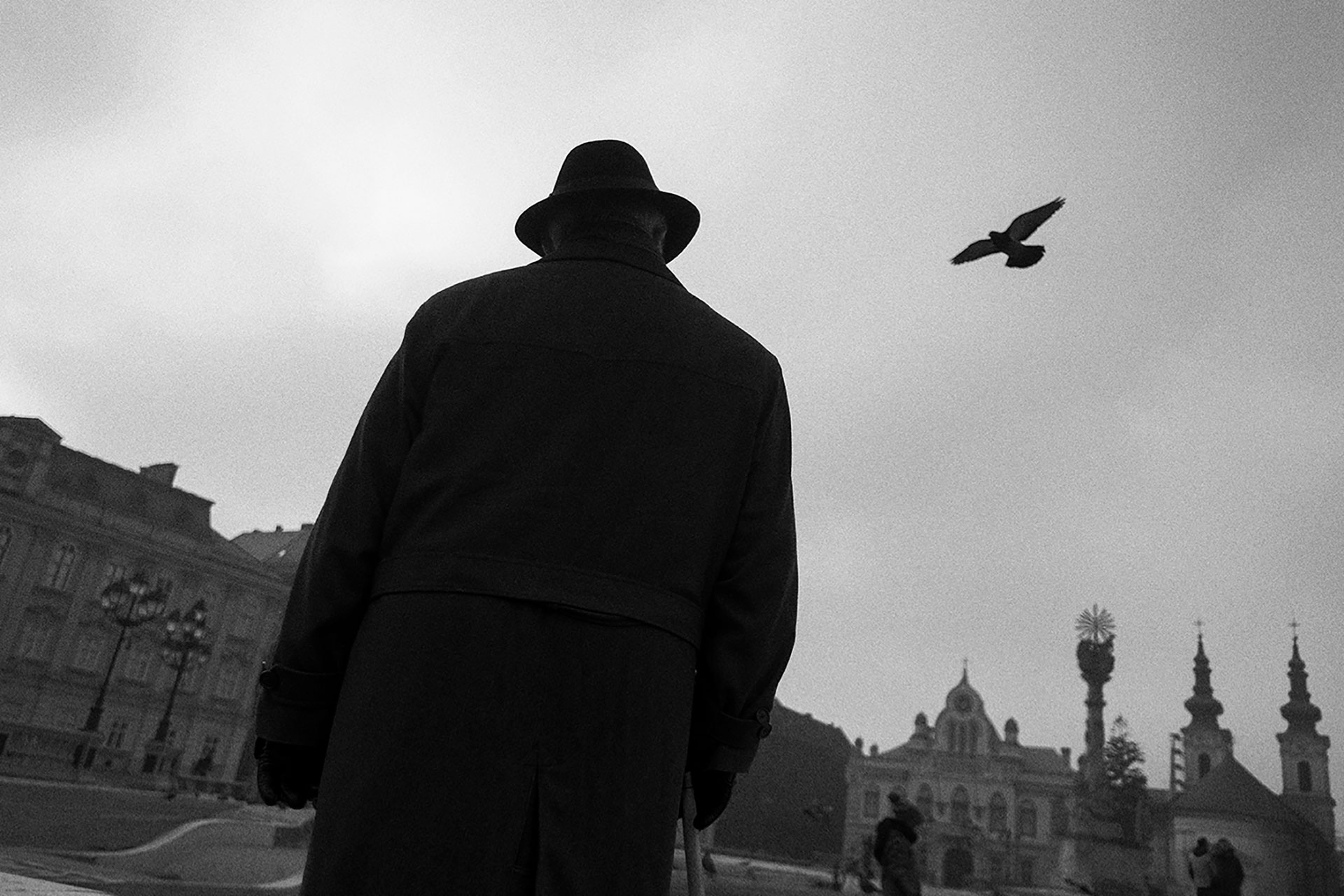
Can you tell us a little about of you and how you got started with Photography ?
I live in Bucharest, Romania, I’m 35 and I’m addicted to photography. Especially to street photography. When I was a boy, I was dreaming of becoming a coreographer or to work in the music industry, but I ended up graduating the Academy of Economic Studies. A total loss of time. I didn’t like it at all. As a student, I started working as an editor and voice over for a radio station, and after graduation I found a job in television. Again, a creative medium. Nowadays I’m still in television, working as a video editor. I am an active person and when I really like something, I totally devote myself to it. No sacrifice is too big. I like to respect people and to be respected. I like to believe that photography is the best medicine, at hand and quite cheap. And it goes very well with music. For the last 3 years I’ve been an admin of the international street photography group On Spot. During all this time I had the pleasure to promote excellent photographers and I got to learn a lot from them. I was part of various street photography exhibitions, as those from the Miami, London, Milano or Bruxelles festivals.
Where do you get your inspiration for Photography?
From films, music and everything related to the visual domain. From the photographs which I see daily, from different talks with my friends. Photo books play an important role as well.
What does ‘street photography’ mean to you?
For the last 5 years, it became some sort of an addiction. Or maybe it was from the beginning, but I have a different understanding of things now. It’s a lifestyle…And even if I wanted to quit more than once, I couldn’t do it.
Who are the Masters of Photography who inspired you most in your photographic works?
Joel Meyerowitz. Trent Parke, Alex Webb, Elliot Erwitt, David Alan Harvey, Constantine Manos have a special place… But there are many otthers.
What first drew you to street photography—and how did you discover it?
I don’t recall exactly what made me want to take photos of what I was seeing. It just came to me I guess. It happened about 15 years ago, when I touched the first camera. Many stories to tell since that day.
Are you believe that observation is the main thing in street photography ?
Yes, observation is a key factor in getting a good image and also in evolving as a photographer. But in order to develop a sense of observation you need to back it with lots of work and patience. Time is no ally either…
Black white or colour and why ?
It doesn’t matter to me if a photograph is in color or in black and white.
It’s the message that matters. I think it’s every photographers decision what he or she wants to pass on. Lately I’ve chosen to edit in color, but this doen’t mean that if an image would look better in bw I won’t edit it that way. It depends a lot on circumstances and the message. In both cases, I try as much as possible to show the mood I observed while photographing, and not to distort things. After all, life is so colorful that it would be a pitty not to show it. I think a photographers should follow their own style, their gut, and the message they want to convey. An image doesn’t have to be in bw to be timeless.
In a street picture, do you think the contrasts of light are important to tell a story or are just an aesthetic fact?
The light can certainly create stories through the shapes it creates. I believe though that it manages to help the composition especially through the volumes that it gives. The study of light in the street is a good exercise…to try to minimalise the composition with the help of light or on the contrary, to paint with light in a complex image.
Taking a shot in the street could be difficult at times; dealing with people’s reactions or making sure it is not invasive in the various situations that could arise, is not always easy. What is your approach in these circumstances?
Getting closer to the subject is a big challenge. You don’t know what the reaction will be and it is always a risk taken. That is why I believe it is important to smile, to be opened, so that you won’t be seen as a menace to them. I get quite close to my subjects, sometimes I shoot from the hip in order not to alter the subject’s state of mind or being in the moment. Once you are being noticed, the photographed ones change their attitude. Things have changed, as the Covid crisis came along and people’s behavior changed. It will be more difficult to get closer. A real challenge now.
What is your approach with your camera when you are shooting unknown people in the street? This is a problem for many photographers: how do you manage it or how did you overcome it?
In the beginning I used to avoid photographing people. Little by little I realized that what doesn’t kill you, it makes you stronger. For me listening to music really works, I act as a tourist in my own city. And people feel that. I have no problem with photographing strangers.
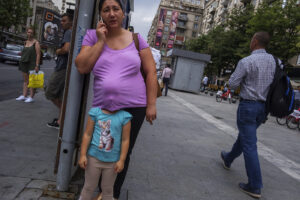
Which subjects, both people and places, inspire you most and make you to look for the shot, or that you think better represent your city and your land?
I think variety is very important in photography. So I try not to think in advance of a subject, when I go out. I might get lucky and catch a candid moment or just the everyday simplicity… Having options is a plus in my opinion. If the location has photographic potential as well, then it’s a real bonus.
Do you think is there something unique in the street photography that distinguishes it from other genres?
Yes, the sincerity and naturalness of the moment. The liberty of not answering in front of anybody for the way you want to depict reality.
In recent years, Street Photography has boomed, what do you think it’s due to? And what evolution has there been?
I would begin with the second question…I think we are dealing with a decline nowadays in street photography. Lots of cliches, people just want to imitate in order to get fast appreciation and recognition. Street photography has boomed judging by the number of images, not necessarily through quality.
What kind of gear do you use?
I use my Fujifilm XT2 with a 8 mm lense , in 95% of the cases.
If you want to start any other categories then which genre do you want to start and why?
I am attracted by documentary photography. You dedicate yourself to a cause, you get pretty involved and it requires lots of time, it needs to let things settle down. It seems very difficult to me, but that is why it is so challenging.
Which are the limits of ethics in a street picture ?
Respect for the photographed people is what matters first and foremost, in my opinion.There is a limit to all things. I try not to get to the limit and not to depict my subject in humiliating way.
Among your works, which one is your favorite? Can you please share this photo?
And please share your best six photos .I can’t name a favorite. I just hope that some day I will have an image that will count for something, or will be able to change something.
How has social media played a role in your photography?
Every Friday, I promote a photographer on a fb page: On Spot Gallery. I’ve seen thousands of images trying to get the best selection for the page and I can say it helped me grow, from a visual point of view. On Instagram also, I discovered many good photographers. Social platforms are a good thing, but only to a certain point.
What tips or advice do you have for others who are started with street photography?
The best advice that I got from a friend, also a photographer, was not to look for the sensational. From that moment on, I started to appreciate much more simplicity, and the banal. Another advice that I would give is for them to try anything, without restrictions, to let their imagination fly and to be inspired by other photographers. Attention though… to get inspired, not to copy, because it’s a big difference. We all sort of change our perception through the images we get to see daily. I think in this case the Internet doesn’t help. What works for me, doesn’t necessarily work for you as well. Without work and practice you can’t achieve too much. I believe that one of the biggest asset a photographer can gave is perseverance. Nothing falls from the sky and you have to make sacrifices and to be passionate enough not to perceive things that way. Another advice is for them to buy photobooks, as nothing compares to watching printed images, to attend workshops when possible and to be opened to new experiences. Also to watch as many films as possible (films with photographic potential) and to be amazed by the things and places they encounter on the way. To write down their ideas, not to be afraid of new things and to believe in themselves because they are unique. Not to forget, modesty is also important. There is no magic recipe, only too short days.
